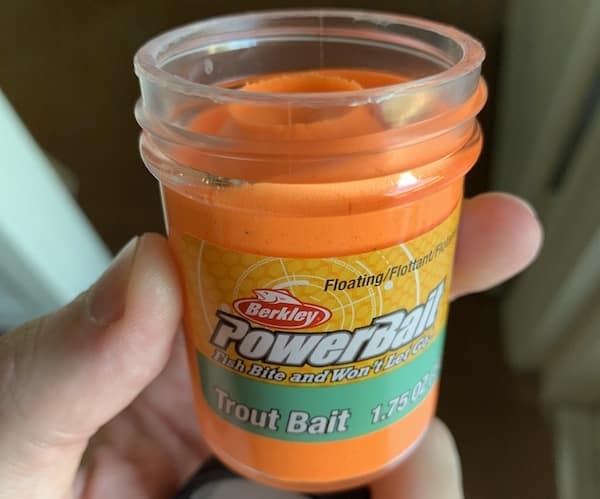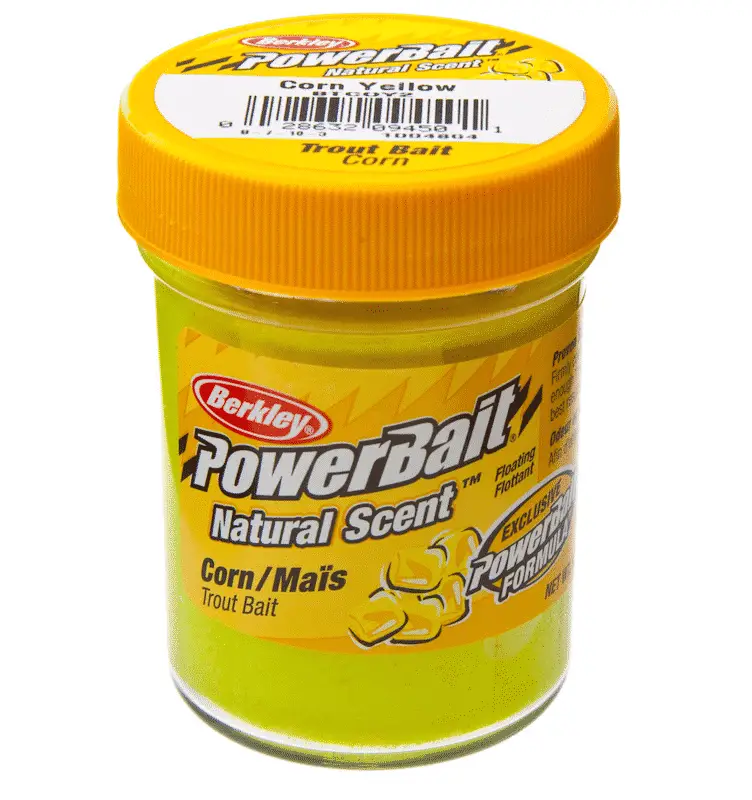I’m currently planning a trip to a stocked river (Guadalupe River), and even though I’ve had success on most varieties of PowerBait, I wanted to find out which types were the BEST to use for stocked trout. So, after some research, here are the top 3 types of PowerBait that I and other trout fishers have found works most often.
(To see the current prices from Bass Pro Shops, click the affiliate links above)
Other than appearance, most PowerBait is almost exactly the same (except if you’re getting one with extra scent or the already-formed Power Eggs). So, rather than pretend like there’s a big difference between these three, let me tell you upfront–there’s not.
While you can use PowerBait worms or eggs, most would agree that the scent is a better lure than the appearance. So, forming the dough into small ball shapes will work for stocked trout on most occasions.
Now, the two main differences between the three options above are solely from their:
- Color
- Ingredients
We’ll get into the best colors later, but for now, let’s focus on the ingredients. The only thing you should know is that PowerBait is normally made from PVC (plastic) and an oil-based resin (also plastic). So, unfortunately, it’s not so great for the environment, or for the trout you may be catching and eating.
So it’s great to see that Berkley is making a biodegradable version now. They mention this version is 92% biodegradable and made from natural silica.
However, if you still prefer the old-fashioned PowerBait, you can still click the link labeled with the “Corn Yellow” coloring.
Let’s move on to why these three colors work so well.
First, let’s take a look at what makes PowerBait so special and why stocked trout hit this neon bait most often.
Why stocked trout like PowerBait
So, why PowerBait? Well, it’s because stocked trout are raised in hatcheries where they’re fed fish food in the form of pellets. PowerBait often mimics the sight, feel, and the scent of the pellets, which makes it an incredibly effective bait.
Pellets used in hatcheries are usually made from several ingredients including grains and oils. The oils, or lipids, are the most calorie-dense part of the pellet, while the grains, such as flour or cornstarch, act as the binders. The result is cheap and calorie-efficient fish food.
PowerBait imitates these pellets and attracts stocked trout. When you’re using PowerBait, most often all you need to do is disguise the bait enough where the trout don’t notice the hook, weight, or line and they’ll usually hit the bait. Unless there’s either a hot day, low air pressure, or the trout are spooked, you’ll find PowerBait to be a great investment when fishing stocked trout.
The best PowerBait color for stocked trout
Bright colors like orange, green, and rainbow are safe choices and will attract most trout. Color is an important element to consider when fishing for stocked trout, but it’s not the only focus.
While there is some speculation about the best colors to use, many say that bright yellow, orange, or rainbow-colored PowerBait work best.
For a full list, here are some of the top colors when using PowerBait for stocked trout:
- Orange
- Green
- Rainbow
- Yellow
- Hatchery pellet
The brighter coloring will help the trout see the bait, but when the weather and water conditions are a bit cloudy or murky, the scent will help get the trout’s attention.
You can also choose some PowerBait that has glitter to help reflect sunlight for even more visibility, but it might not make too much of a difference.
The color orange normally works incredibly well because it stands out and often looks like salmon eggs, which is a common food for trout.
For yellow PowerBait, colors come in “corn” and “cheese”, both of which are effective.
Lastly, there’s some coloring that resembles garlic and even hatchery pellets. While the hatchery pellet color is darker than most other colors, stocked trout have a sense of nostalgia for the pellets they were fed in the hatchery and will often eat them from muscle memory. These colors would also be a good choice to use at night.
How to rig PowerBait
You can start rigging PowerBait by using a 6-pound monofilament and threading a bullet weight through it. Place a barrel swivel below the weight and then follow it with a fluorocarbon leader. Use a size 6 circle hook and roll the PowerBait into a small ball, but still enough to hide the hook.
Before we look further into rigging PowerBait, we should have an idea of a few factors such as how deep the water is and where the trout are biting. This will help determine the color and length of the leader and other parts of the rig.
Let’s start with locating trout. Depending on the weather and air pressure, most stocked trout bite at a depth of 2-4 feet. Find areas that have some cover like rocks, bushes, or grass as trout will often use them to rest and avoid predators. It’s also easy for them to dart out of cover, grab whichever critter is floating their way, and dart back.
If you’ve worked your current area, and you aren’t having any luck, trying moving up or down the lake or creek. Odds are you’ll be able to spot some potential areas like a drop off from the bank that the trout are likely hiding in, and hopefully land a few.
Rod
Stocked trout are fun to catch, but having the right rod will help you feel the trout strike the PowerBait and make reeling them in more enjoyable. Using a light or ultralight rod will prove to be a good investment and make it feel like the trout are pulling harder. Also, there is the added benefit of light rods casting lightweight bait farther (perfect for lightweight PowerBait rigs).
Leader
When determining how your presentation should look, first consider using a good leader setup. The proper leader length will depend on how many weeds there are at the bottom of the lake or creek. If you’re pulling up grass, weeds, or slime on your rigs, add some length to your leader.
Line
For your line, use the lightest line that you are comfortable with. I like using a 6-pound monofilament test for my main line and a 4-6 pound fluorocarbon leader, but others do well with 4-pound line and 2-pound leader.
Hook
When choosing a hook, I like to use a size 6 circle hook and flatten the barb to help make the hook easy to remove. It also causes less damage and fewer gut hooks.
Please do not use a treble hook with your PowerBait. Using a circle hook instead of a treble hook makes a huge difference when it comes to best catch and release practices. You’ll have fewer gut hooks and the survivability of the stocked trout will be much higher. Not to mention the time and effort you’ll have saved by not removing those gut hooks.
Sinkers
Bullet weights happen to be some of the best options out there when it comes to sinking PowerBait. If you currently use split-shots, you may want to reconsider. Trout are picky about the appearance of the rig, and that includes the weight. If they test the bait and feel the resistance of the sinker pulling back on it, they’ll leave it and move on.
For best results, use a bullet weight in combination with a barrel swivel. To do this, thread a bullet weight on your main line (with the pointed end facing up) and below that, tie on a barrel swivel using a Trilene Knot.
Next, tie on your leader (with another Trilene Knot or your preferred knot) on the other half of the barrel swivel. The length of the leader is up to you. You should use a length that works best for not only how high you want the PowerBait to float off the bottom, but also for your casting. Casting with a 1-foot leader is much easier than a 3-4 foot leader.
Lastly, tie on your hook and you have your rig almost all set to go. The last part is just the bait.
Size and shape of the PowerBait
To make the PowerBait a good size for catching trout, start off by breaking off a chunk and forming a small ball in the size of a blueberry. If you buy the PowerBait eggs, then you don’t need to shape it or do anything extra.
Some like to shape PowerBait into worms or grubs, but most would argue that when it comes to the presentation, the scent is more effective than the shape of the bait. As long as you’re covering the hook for the most part, and disguising the line with a leader or color similar to the water, the trout shouldn’t be able to spot the rig.
To recap, a good example rig for PowerBait is to use:
- 1.5-2 foot leader with a 2-6 pound test
- 6-pound braid or monofilament main line
- Size 6 circle hook (I recommend flattening the barb with pliers)
- Your choice of PowerBait, shaped into a small ball
Which colors do trout see best?
A trout’s color range is similar to ours, except they have a fourth color receptor. This allows them to see dark blue bait as bright blue and additionally see ultraviolet colors, which we cannot. Although they have great vision during the day, trout cannot see in color at night.
Finding a color of PowerBait that won’t blend into the water or bottom of the lake is key. Feel free to experiment, but default to the orange, green, or rainbow if you aren’t having any luck with the others (it might be a good idea to carry one of these three as a backup bait in your tackle-box).
However, if you’re fishing at night, it can be best to use a dark PowerBait. This is because trout can only see in contrast at night.
Because trout cannot see in color at night, the silhouette of the bait can stand out easily against the night sky. So when a curious trout sees the silhouette, the scent of the bait should seal the deal.
When fishing at night, try to get PowerBait that reflects at least some light to help trout locate the different shades of grey. The hatchery pellet with glitter would work well in this case.
Lastly, trout are exceptionally good at spotting fishing line since it often differs from the color of the water. For best results, try matching your line to the body of water you’re going to be fishing in. If you’re not interested in changing the line out each time you go out to a new fishing spot (I don’t blame you), then matching the leader color is to the water will also work. This isn’t as necessary with fluorocarbon leaders because of its invisibility underwater.
Is color or scent better when it comes to PowerBait?
Overall, most PowerBaits will work, but the effectiveness comes down to not only using a bright color but also one with a strong scent. Because of this, most PowerBaits come with a “natural scent” and should be enough for most types of trout fishing.
However, if you’ve had your bait on the hook for a while and haven’t had any bites, it could have lost its scent and you might want to rebait.
You can also add PowerBait to the end of your hook(s) for other bait, such as if you’re using crayfish. Surprisingly, trout love crayfish and they’re a great bait to use if available.
Make your own PowerBait at home
If you’re interested in making your own PowerBait at home, know that it’s super cheap and easy. Although it’s not the same consistency as PowerBait, it’s just as effective. All it takes is some flour, cornmeal, garlic powder, and water. I recently made a post about making homemade dough balls to catch trout, so feel free to check it out.
An even easier alternative is buying a can of sweetcorn. It’s better for the environment than PowerBait and can be found dirt cheap at almost any grocery or convenience store.
Related questions
Do trout bite after being stocked?
While some stocked trout are a bit timid after being recently stocked, others will immediately start searching for food. Although, they still have their instinct to also seek shelter from predators by hiding in grass or under natural shelter.
Where do trout go after being stocked?
Even though trout are usually dumped together in the same location, they won’t stay there for long. They’ll start relocating almost immediately up or downstream. For the best chance of finding them, look for water 2-4 feet deep and spots that have some natural overhang.



